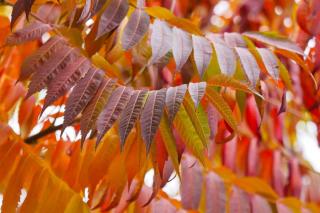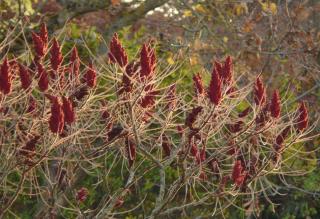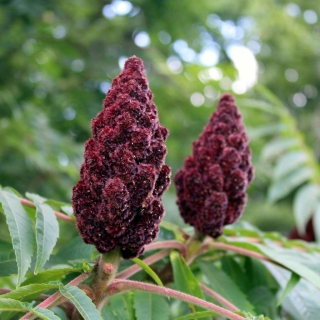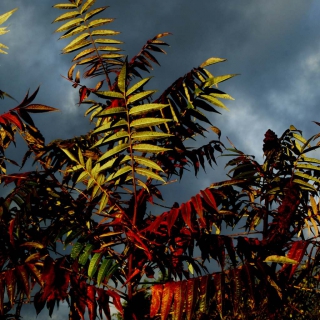

Staghorn sumac, also called vinegar sumac, is a short tree that grows in a roundish shape.
Key staghorn tree facts:
Name: Rhus typhina
Family: Anacardiaceae
Type: shrub
Height: 16 feet (5 m)
Exposure: full sun
Soil: ordinary
Foliage: deciduous – Flowering: June to August
It’s found very appealing for its fuzzy red fruit clusters, but sometimes becomes problematic because it spreads very fast.
 It doesn’t make any difference whether your staghorn tree is planted in spring or fall.
It doesn’t make any difference whether your staghorn tree is planted in spring or fall.
Propagation through root cuttings in fall, but you can also just wait for it to send shoots up from the running roots and dig those out.
 Staghorn sumac can turn out to be rather invasive, both because its seeds sprout easily and because underground roots send up shoots. In pruning, your goal is to keep the tree as a single, balanced tree.
Staghorn sumac can turn out to be rather invasive, both because its seeds sprout easily and because underground roots send up shoots. In pruning, your goal is to keep the tree as a single, balanced tree.
→ Before pruning your staghorn sumac, slip on a pair of gloves, because the sap is a bit sticky (and, for some people, highly irritating).
Staghorn sumac has rather brittle wood that can’t cope very well with windstorms. Never climb into the tree to prune it, and don’t even think of hanging a swingset from it.
Staghorn sumac will bounce back from even the hardest pruning. If you cut it down to a stump, new shoots will reappear in the following spring from the vigorous root system. It’s as strong a grower as bay in this respect.
Hatracking, or cutting back completely just to shorten the tree, is strongly discouraged. Indeed, new branches would come out that are only weakly connected to the tree. On a staghorn tree, these branches would very easily break off if it gets windy. Dangerous if people walk nearby. Not a problem if you contain growth to less than 6-8 feet (2-2.5 meters).
That being said, it’s best to simply shorten the longest branches by cutting them back to a junction. For example, if a branch splits into two smaller branches, cut the longer of the two back to the junction. If the tree still feels too large, go for a second round. Best do this in fall, after leaves have fallen.

It is definitely among the most beautiful ornamental shrubs from September to December.
This easy to care for shrub will produce the nicest impact as a standalone, because as years go by it tends to grow wide instead of tall.
Staghorn sumac fruits can be used to prepare lemonade, all that has to be done is to prepare a decoction from the fruits. It’s a relative of both cashew and pistachio nut trees.
The tangy, acidic taste gave the tree its other common name: the vinegar tree. Its fruits contain high doses of vitamin C and tannin compounds.

However, especially after repeated contact, some people turn out to be vulnerable to staghorn sumac’s sap.
Too much exposure to that white, milky sap called latex might trigger an allergic reaction.
This usually isn’t anything more than dermatosis, rashes or swelling on the hands and forearms, but in some cases it may lead to severe anaphylactic shock, where the blood pressure drops to the point of losing consciousness and swelling of tissues in the throat and mouth area can lead to choking.
Read also on the topic of shrubs:
Planting this unique tree in your garden will bring lots of color to your garden!
Staghorn sumac leaves will gradually shift from spring green to carmine red, with shades of daffodil yellow and lush orange.
Your comment is awaiting moderation.
Your comment is awaiting moderation.
Staghorn Sumac has taken over our back yard after years unattended.It is hard to contain it,needing mowing or pulling new sprouts and roots every other week.Can I burn it off in our fire pit like I would most other wood?Or is it toxic to burn ?
A bought some staghorn sumac 30 years ago in Galena IL from a local landscaper. A big mistake! I asked him for a variety that wouldn’t get too tall and produce a colorful patch for privacy. Over the early years they really took off! But they started to become trees rather than shrubs to say the least! They took over getting taller and taller. I had to start cutting them down as they were starting to grow on my neighbors property. It took several years to remove them. What a relief!!! I haven’t seen anymore sprouts in years. Guess what… about a dozen shoots popped up this summer. What’s the best way to eradicate them?
Your comment is awaiting moderation.
I was gifted with 3 Staghorn Sumacs 4 yrs ago. They are now 18 – 20 ft tall no blooms . I would like to cut down this Fall to try to have them bush out – is that possible. Will they ever produce fruit?
Hi Mary! There’s a bit more information on pruning staghorn sumac in the article now.
It’s a good idea to cut them back this fall. They will definitely bush out well. Note that they might also send up new growth/shoots from the ground in spring. You should remove most of them, or else you’re going to end up with a thicket that’s impossible to control later on.
For the blooming/fruiting, yes they will certainly start producing that soon; possibly even next year if you prune them this fall. Indeed, pruning tends to trigger fruiting on most types of tree. I’ve had a sumac start bearing flowers the year after I pruned it, it was late compared to its “siblings” because it had too much shade. The pruning did the trick for this one!
This article should be updated. Rhus toxicodendron and Rhus vernicifera are now recognized as part of the Toxicodendron genus rather than Rhus. They might be confused with each other at certain times of year, but they are noticeably different plants.
Hi Randy, you’re right – I was able to find a few genetic analysis studies that corroborate that fact. Though it does seem that establishing lineage for all these plants is particularly difficult, since sometimes results are conflicting even nowadays. I updated the article now to reflect this for the two species you mentioned. Thanks a lot!
Good morning, we have a beautiful stagshorn sumac tree with stunning red candles, I decided to trim lower branches off so I could get the mower underneath. Ten to fifteen minutes later I started to get a red stinging rash on my face lips and neck, my pulse shot up-to 138, I had vomiting, diarrhea and then blacked out, my partner had to call an ambulance ,I was told I had experienced a severe allergic reaction to the tree.
I know this tree is not generally known to be toxic so we were baffled. However we did manage to find a few people who had suffered the same reaction as me. So I was thinking when selling this beautiful tree to the public it might be worth mentioning that some people could have a severe allergic reaction to the sap. I know that the poisonous sumac is very poisonous, but I was very surprised to know that the stagshorn is also poisonous. Avril
Hello Avril, that’s a very important insight and I thank you a lot for sharing it. It turns out that the sap of the plant does trigger allergies, and the probability increases with how often a person comes in contact with the substance. How serious the allergy becomes, though, depends on the person: some will only experience minor discomfort while others risk dangerous allergic shock reactions.